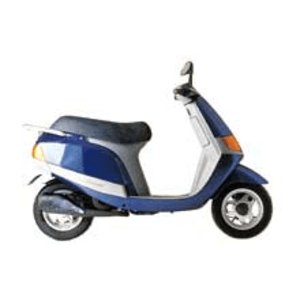Piaggio Sfera 50 (1995-1997) Review: A Nostalgic Ride Through 90s Scooter Culture
Introduction
The mid-90s were a golden era for urban mobility in Europe, and the Piaggio Sfera 50 stands as a time capsule of that period. Designed as a no-nonsense commuter scooter, the Sfera 50 prioritized simplicity, affordability, and practicality over flashy features. Two decades later, this little two-stroke machine still holds a cult following among vintage scooter enthusiasts. But how does it hold up today? I spent a week with a meticulously maintained 1996 model to find out.
Let’s be clear: the Sfera 50 isn’t about speed or adrenaline. It’s about the joy of zipping through narrow city streets with the mechanical honesty of a carbureted engine and the wind in your hair. This review isn’t just a specsheet recap—it’s a love letter to an era when scooters were uncomplicated workhorses.
Design & Ergonomics: Pure 90s Functionality
The Sfera 50’s design is a masterclass in utilitarian aesthetics. The bodywork features soft, rounded edges—a stark contrast to today’s angular scooters. The flat, wide seat (800 mm/31.5" height) accommodates riders of all sizes, though taller riders might feel slightly cramped during longer rides.
Key Highlights:
- Storage: The underseat compartment fits a small bag or groceries, but not a full-face helmet—a reminder that 90s riders prioritized minimalism.
- Instrument Cluster: A single analog speedometer and basic warning lights keep things refreshingly simple. No digital distractions here.
- Weight: At 89 kg (196 lbs), even novice riders can maneuver it effortlessly. Parking? Just lift the rear end and pivot.
The chrome accents and dual-tone paint options (think burgundy-red or seafoam-green) scream retro charm. Modern riders might miss LED lights or smartphone connectivity, but the Sfera’s analog soul is part of its appeal.
Performance: The 2-Stroke Symphony
Powered by a 49.9cc air-cooled two-stroke single-cylinder engine, the Sfera 50 delivers 3.8 PS (2.8 kW)—enough for city commutes but not much else. The engine’s character is unmistakably 90s two-stroke:
- Throttle Response: Snappy at low RPMs, with a satisfying buzz as you hit 1900±100 RPM idle. The carbureted engine (4.0 turns on the air screw) requires patience in cold starts but rewards with linear power delivery.
- Top Speed: 45-50 km/h (28-31 mph) on flat roads—perfect for urban grids but hesitant on steep hills.
- Fuel Economy: Sips fuel at ~35 km/l (82 mpg), thanks to the 6.2L tank.
The direct-drive CVT transmission eliminates gear shifts, making it ideal for stop-and-go traffic. However, the lack of a kickstarter means you’re reliant on the electric starter—a potential pain point if the battery ages.
Handling & Ride Quality: Urban Ninja
Where the Sfera 50 truly shines is in its agility. The short wheelbase and 10-inch wheels make it feel like an extension of your body:
- Maneuverability: Weaving through traffic or executing U-turns on narrow streets is laughably easy.
- Suspension: Basic hydraulic forks and twin rear shocks handle potholes better than expected, though rough roads will jostle your spine.
- Brakes: Mechanical drum brakes front and rear require deliberate lever pulls. Not confidence-inspiring by modern standards but adequate for sub-50 km/h speeds.
Tire pressure is critical here: 1.2-1.8 bar (17-26 psi) upfront and 1.75-2.5 bar (25-36 psi) at the rear. Underinflated tires exacerbate the already vague cornering feel.
Competition: How Does It Stack Up?
The 90s 50cc scooter segment was fiercely competitive. Here’s how the Sfera 50 fared against its rivals:
- Honda Tact (1994-1999):
- Tact’s 4-stroke engine was cleaner and quieter but lacked the Sfera’s peppiness.
-
Honda’s build quality edged out Piaggio, but the Sfera was cheaper to maintain.
-
Yamaha Jog R (1995):
-
Yamaha’s 2-stroke was sportier, with a 60 km/h top speed. However, its tighter ergonomics suited smaller riders.
-
Aprilia SR50 (1993-1997):
- The SR50’s liquid-cooled engine and disc brakes were more advanced but pricier to repair.
Verdict: The Sfera 50 wasn’t the fastest or most refined, but its balance of simplicity and low running costs made it a favorite among students and delivery riders.
Maintenance: Keeping the 2-Stroke Alive
Owning a vintage Sfera 50 requires dedication. Here’s what to watch:
- Engine Oil: Uses 1.4L of 2-stroke oil (premix or auto-lube). Always carry a spare bottle—MOTOPARTS.store stocks Castrol Power 1 2T for optimal smoke control.
- Spark Plugs: NGK B9ES (standard) or BR9EIX (iridium upgrade). Check the 0.6 mm electrode gap monthly.
- Drivetrain: The direct-drive system needs occasional belt inspections. Swap worn belts early to avoid stranding.
- Brakes: Drum shoes wear quickly in stop-and-go traffic. MOTOPARTS’s EBC OEM replacements improve bite.
Pro Tip: Clean the carburetor annually and adjust the air screw to 4.0 turns for smooth idling.
Conclusion: A Charming Relic
The Piaggio Sfera 50 isn’t just a scooter—it’s a gateway to 90s nostalgia. Its quirks (like premixing fuel or adjusting valve timing) are part of the charm. While modern scooters outclass it in every technical metric, few can match its personality.
For MOTOPARTS.store shoppers, the Sfera 50 offers endless tinkering opportunities. From performance exhausts to retro mirrors, keeping this classic alive is a labor of love. If you’re craving a slow-paced, analog riding experience, the Sfera 50 delivers in spades.
Ride it. Fix it. Repeat.



















